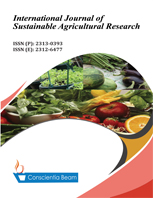Soil fertility status and its possible sustainable agricultural packages in Bangladesh
DOI:
https://doi.org/10.18488/ijsar.v10i1.3273Abstract
Soil fertility describes the soil's capacity to support the growth of agricultural plants for predictable yields. Consequently, the present study was conducted on twenty one soil series of Bangladesh, including Sonatala, Sherpur, Ghatail, Balina, Melandaha, Tarakanda, Gorargaon, Karail, Raipur, Ruhea, Silmandi, Dhamrai, Jamun, Ishurdi, Ranisankail, Atwari, Gangachora, Pirgachha, Sulla, Birampur, and Gopalpurand to know the fertility status and its possible sustainable agricultural packages. The textural classes of the major soils were silt loam. The soils had the particle densities ranged from 1.79 to 2.50 g cm-3. The soil series from Sherpur and Gangachora had the highest particle density, while those from Karail and Gorargaon had the lowest value. Most soils reacted in a neutral to acidic manner, whereas the Ishurdi and Gopalpur series showed an alkaline response. Except Karail and Gorargaon, the organic matter status was very low to medium. The total N content of the soils ranged from 0.04 to 0.19%. The available phosphorus, exchangeable potassium, and available sulphur of soils ranged from 2.82 to 22.18 ppm, 0.09 to 0.26 meq/100g soil, and 2.90 to 20.30 ppm, respectively. The results revealed that the soils in the research area were very low to moderately fertile. Therefore, balance fertilizer must be applied in time in the study area. The fertilizer should be location-specific, cropping pattern-based, and based on soil testing. Beside this, a collection of management techniques have to be acknowledged and promoted to the farmer level as a package for sustainable agriculture that enhances food security.

